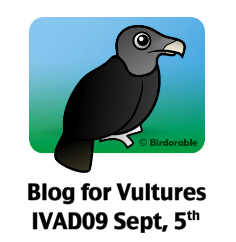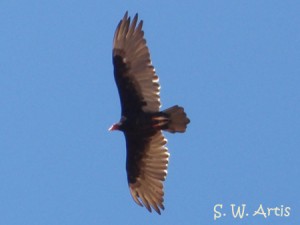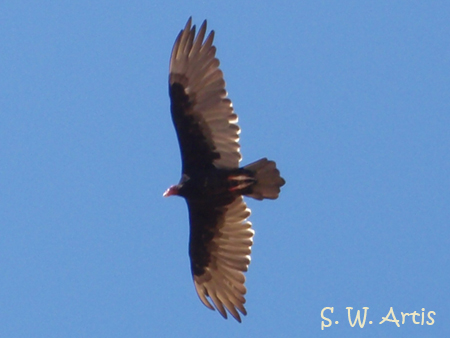 The day of riding the virtual thermals is finally here. International Vulture Awareness Day 2009 circles the globe on September 5th and to join in the festivities I decided to share a little information about the event that is taking place with the help of more than 140 organizations worldwide, and provide some information about a local vulture.
The day of riding the virtual thermals is finally here. International Vulture Awareness Day 2009 circles the globe on September 5th and to join in the festivities I decided to share a little information about the event that is taking place with the help of more than 140 organizations worldwide, and provide some information about a local vulture.
According to the IVAD 2009 website:
On September 5, organizations all over the world are organizing activities to highlight vulture conservation and to raise awareness. Events are being held in:
Argentina | Austria | Bangladesh | Belgium | Bulgaria | Croatia | Czech republic | France | Germany | Hungary | India | Israel | Kazakhstan | Kenya | Kyrgyzstan | Macedonia | Malta | Mexico | Mongolia | Nepal | Netherlands | Pakistan | Poland | Slovenia | South Africa | Spain | Thailand | United Kingdom | United States | Zambia
Vultures are an ecologically vital group of birds that face a range of threats in many areas that they occur. Populations of many species are under pressure and some species are facing extinction.
The International Vulture Awareness Day has grown from Vulture Awareness Days run by the Birds of Prey Working Group in South Africa and the Hawk Conservancy Trust in England, who decided to work together and expand the initiative into an international event.
 In my neck of the East San Francisco Bay Area, the most prominent vulture feature that graces our skies is the Turkey Vulture. In fact the Turkey Vulture, who received its name from the bald head that resembles that of a Wild Turkey, is a fairly common bird in North and South America. And with the ever expanding number of roads and traffic, an increase in Turkey Vultures capitalizing on roadkills in urban areas is not surprising. Whether on a highway or hidden within the thickest of forests, carrion is easily scavenged because of a well developed sense of smell.
In my neck of the East San Francisco Bay Area, the most prominent vulture feature that graces our skies is the Turkey Vulture. In fact the Turkey Vulture, who received its name from the bald head that resembles that of a Wild Turkey, is a fairly common bird in North and South America. And with the ever expanding number of roads and traffic, an increase in Turkey Vultures capitalizing on roadkills in urban areas is not surprising. Whether on a highway or hidden within the thickest of forests, carrion is easily scavenged because of a well developed sense of smell.
Speaking of smells, scientists and engineers have found that Turkey Vultures are attracted to ethyl mercaptan fumes that simulate the smell of carrion and rotting meat. Thus, by spiking pipelines with the chemical, engineers can locate leaks in long stretches of piping by watching for places where the vultures gather.
At a weight up to 4.5 pounds, a length of 30 inches, and a wingspan up to 6 feet, the Turkey Vulture, like other heavy soaring birds, requires the sun to gather strength and warm the ground before taking flight. It is not uncommon to see the vultures perched and spreading their wings in the morning sunshine while the thermals are forming for the day. Once the ground has warmed, the heat has been transferred to pockets of air, and enough energy is available for it to rise, the vultures will take flight and cruise the thermals in search of prey. After entering a thermal, the vulture can rise at speeds up to 16 feet per second.
And interestingly enough, there is a difference between New World and Old World vultures that is not just anatomical but genetic. According to studies, DNA suggests that American vultures are not closely related to Old World vultures and convergent evolution resulted in similar features such as body shape and bald heads.
So go out this weekend for a little vulture watching, explore the IVAD09 Blog Festival, and see what IVAD 2009 events are taking place in your neighborhood.
Turkey Vulture Identification Tips:
• Length: 25 inches Wingspan: 72 inches
• Sexes similar
• Very large, broad-winged, soaring bird
• Long and rounded tail
• Longish, hooked bill
• Rather short, thick legs
• Holds wings in a dihedral angle while soaring and gliding
• Spends most time soaring, infrequent flaps are slow and laborious
• Small, unfeathered head
• Plumage dark brown except for paler flight feathers, appearing black and gray
• Immature like adult
Adult:
• Red head
• Yellowish bill
• Reddish legs
Immature:
• Gray head
• Gray bill
• Gray legs


[…] this page was mentioned by Julia Schreuder (@juliasrq), Bay Nature (@baynature), Pat Bumstead (@patbumstead), journowl (@journowl) and others. […]
Very interesting read Scott.
I had no idea about vultures being used to locate leaks in piping. I hope the vultures don’t waste too much energy. Do you know if they get rewarded for their work?
Wow…what a lovely post! Packed with info and beautifully written…loved reading it!
Great post Scott! Lots of interesting information there. Thanks for sharing!